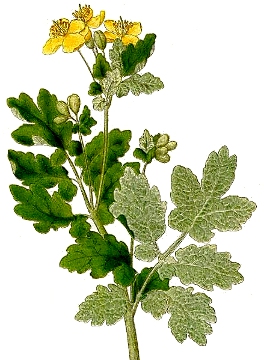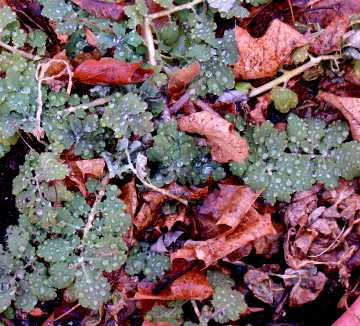 Chelidonium
majus Chelidonium
majus
Greater Celandine
Known as witch's flower in
Somerset, greater celandine is a European native from the poppy family.
Its dedication to Sun, Elemental Fire, and Imbolc is betrayed not only
by its bright yellow flowers but its distinctive sap, which is Sun
yellow instead of Moon white, like that of its cousin, the breadseed
poppy.
 The sap
is very bitter and acrid, but that is mostly destroying by drying or
heating. Greater celandine is often
involved in charms offering protection from the authorities, success in
court cases,
and generally for escape from bondage. There's a strong connection to
the eyes in the name, since the folklore is that swallows would use
greater celandine to restore the eyes of their chicks that had
been pecked. This magic herb has been
cultivated by Europeans since at least 1672. It is also known
as witches' flower, tetterwort (=skin), killwart, wart flower,
wartweed, felonwort (=finger), cockfoot, devil's milk, swallowwort,
wretweed, and kenningwort (=sight, although that has the implication of
knowledge as well). Top The sap
is very bitter and acrid, but that is mostly destroying by drying or
heating. Greater celandine is often
involved in charms offering protection from the authorities, success in
court cases,
and generally for escape from bondage. There's a strong connection to
the eyes in the name, since the folklore is that swallows would use
greater celandine to restore the eyes of their chicks that had
been pecked. This magic herb has been
cultivated by Europeans since at least 1672. It is also known
as witches' flower, tetterwort (=skin), killwart, wart flower,
wartweed, felonwort (=finger), cockfoot, devil's milk, swallowwort,
wretweed, and kenningwort (=sight, although that has the implication of
knowledge as well). Top
How to Grow Greater Celandine
 These seeds germinate best after cold
stratification. You can plant them outside in a protected area in the
fall, or sprinkle them in a paper towel that has been wet with a
solution of water and liquid kelp and then wrung out. Fold up the towel
and put it inside a thin plastic bag (don't zip closed). Put outside in
a protected area like an unheated garage or a porch or shed in the
fall. Leave it out there until early spring, when you can begin to
check for germination. Carefully transfer the germinated seeds to
planting soil. Or just plant outside in fall, barely covering the
seeds. This magic herb loves moist, rich soil under trees, where it
adds bright little Suns with its flowers. It can grow in full shade or full sun (where it
doesn't get too hot) but seems to like dappled shade best. It likes
alkaline soil, so grow next to a concrete or stone wall or add some
stones to the top of the soil if in a pot. It gets about 2ft/.5m tall
and just as wide. The plant flowers April-September and is pollinated
by all sorts of bees and bugs. The pods form from the center of each
flower, gradually elongating. The pods split and drop many seeds to the
ground. These seeds are also harvested by ants, who carry them away so
they can eat the little fasteners on the seeds. This doesn't hurt the
seed, and the ants end up planting them elsewhere. This perennial is
hardy from zones 4 (-30F/-34C) to 8 (so not too hot, but it can stand
some cold). It is an aggressive self-sower in some conditions, so if
you feel any worry about that, grow it in a pot. General
growing info Top These seeds germinate best after cold
stratification. You can plant them outside in a protected area in the
fall, or sprinkle them in a paper towel that has been wet with a
solution of water and liquid kelp and then wrung out. Fold up the towel
and put it inside a thin plastic bag (don't zip closed). Put outside in
a protected area like an unheated garage or a porch or shed in the
fall. Leave it out there until early spring, when you can begin to
check for germination. Carefully transfer the germinated seeds to
planting soil. Or just plant outside in fall, barely covering the
seeds. This magic herb loves moist, rich soil under trees, where it
adds bright little Suns with its flowers. It can grow in full shade or full sun (where it
doesn't get too hot) but seems to like dappled shade best. It likes
alkaline soil, so grow next to a concrete or stone wall or add some
stones to the top of the soil if in a pot. It gets about 2ft/.5m tall
and just as wide. The plant flowers April-September and is pollinated
by all sorts of bees and bugs. The pods form from the center of each
flower, gradually elongating. The pods split and drop many seeds to the
ground. These seeds are also harvested by ants, who carry them away so
they can eat the little fasteners on the seeds. This doesn't hurt the
seed, and the ants end up planting them elsewhere. This perennial is
hardy from zones 4 (-30F/-34C) to 8 (so not too hot, but it can stand
some cold). It is an aggressive self-sower in some conditions, so if
you feel any worry about that, grow it in a pot. General
growing info Top
|
Chelidonium majus
Greater Celandine
50 Seeds $4.00
Uses in Witchcraft & Magic:
Protection from
the Authorities
Escape
Court Success
Second Sight
Sun/Fire Herb
©
2014-2024 Alchemy Works; No reproduction of any part without permission.
|
 Chelidonium
majus
Chelidonium
majus The sap
is very bitter and acrid, but that is mostly destroying by drying or
heating. Greater celandine is often
involved in charms offering protection from the authorities, success in
court cases,
and generally for escape from bondage. There's a strong connection to
the eyes in the name, since the folklore is that swallows would use
greater celandine to restore the eyes of their chicks that had
been pecked. This magic herb has been
cultivated by Europeans since at least 1672. It is also known
as witches' flower, tetterwort (=skin), killwart, wart flower,
wartweed, felonwort (=finger), cockfoot, devil's milk, swallowwort,
wretweed, and kenningwort (=sight, although that has the implication of
knowledge as well).
The sap
is very bitter and acrid, but that is mostly destroying by drying or
heating. Greater celandine is often
involved in charms offering protection from the authorities, success in
court cases,
and generally for escape from bondage. There's a strong connection to
the eyes in the name, since the folklore is that swallows would use
greater celandine to restore the eyes of their chicks that had
been pecked. This magic herb has been
cultivated by Europeans since at least 1672. It is also known
as witches' flower, tetterwort (=skin), killwart, wart flower,
wartweed, felonwort (=finger), cockfoot, devil's milk, swallowwort,
wretweed, and kenningwort (=sight, although that has the implication of
knowledge as well).  These seeds germinate best after cold
stratification. You can plant them outside in a protected area in the
fall, or sprinkle them in a paper towel that has been wet with a
solution of water and liquid kelp and then wrung out. Fold up the towel
and put it inside a thin plastic bag (don't zip closed). Put outside in
a protected area like an unheated garage or a porch or shed in the
fall. Leave it out there until early spring, when you can begin to
check for germination. Carefully transfer the germinated seeds to
planting soil. Or just plant outside in fall, barely covering the
seeds. This magic herb loves moist, rich soil under trees, where it
adds bright little Suns with its flowers. It can grow in full shade or full sun (where it
doesn't get too hot) but seems to like dappled shade best. It likes
alkaline soil, so grow next to a concrete or stone wall or add some
stones to the top of the soil if in a pot. It gets about 2ft/.5m tall
and just as wide. The plant flowers April-September and is pollinated
by all sorts of bees and bugs. The pods form from the center of each
flower, gradually elongating. The pods split and drop many seeds to the
ground. These seeds are also harvested by ants, who carry them away so
they can eat the little fasteners on the seeds. This doesn't hurt the
seed, and the ants end up planting them elsewhere. This perennial is
hardy from zones 4 (-30F/-34C) to 8 (so not too hot, but it can stand
some cold). It is an aggressive self-sower in some conditions, so if
you feel any worry about that, grow it in a pot.
These seeds germinate best after cold
stratification. You can plant them outside in a protected area in the
fall, or sprinkle them in a paper towel that has been wet with a
solution of water and liquid kelp and then wrung out. Fold up the towel
and put it inside a thin plastic bag (don't zip closed). Put outside in
a protected area like an unheated garage or a porch or shed in the
fall. Leave it out there until early spring, when you can begin to
check for germination. Carefully transfer the germinated seeds to
planting soil. Or just plant outside in fall, barely covering the
seeds. This magic herb loves moist, rich soil under trees, where it
adds bright little Suns with its flowers. It can grow in full shade or full sun (where it
doesn't get too hot) but seems to like dappled shade best. It likes
alkaline soil, so grow next to a concrete or stone wall or add some
stones to the top of the soil if in a pot. It gets about 2ft/.5m tall
and just as wide. The plant flowers April-September and is pollinated
by all sorts of bees and bugs. The pods form from the center of each
flower, gradually elongating. The pods split and drop many seeds to the
ground. These seeds are also harvested by ants, who carry them away so
they can eat the little fasteners on the seeds. This doesn't hurt the
seed, and the ants end up planting them elsewhere. This perennial is
hardy from zones 4 (-30F/-34C) to 8 (so not too hot, but it can stand
some cold). It is an aggressive self-sower in some conditions, so if
you feel any worry about that, grow it in a pot.